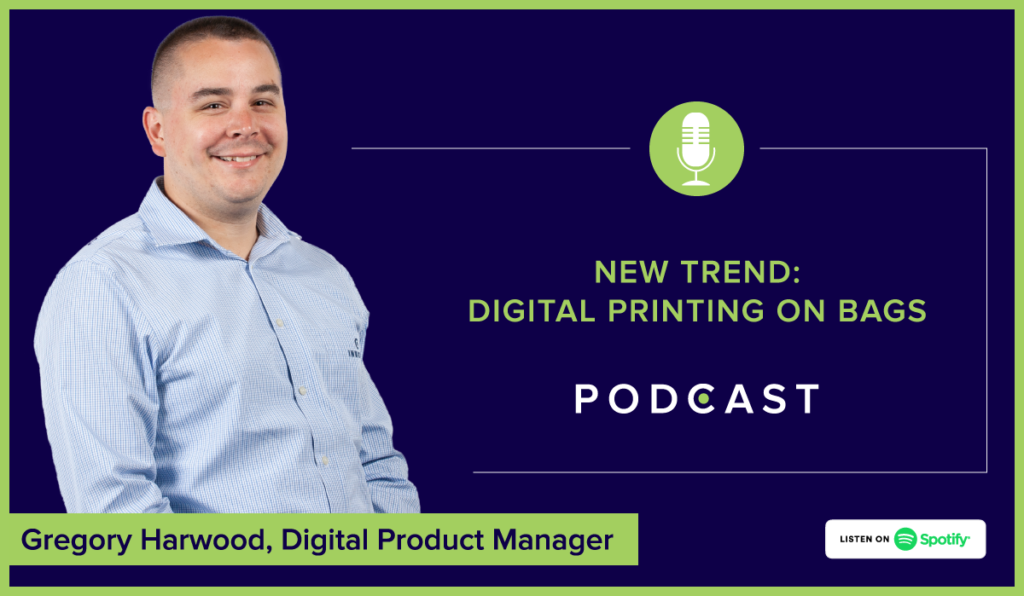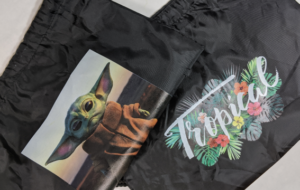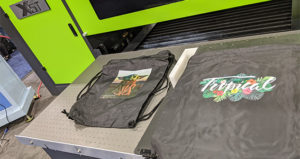- Equipment
- Inks & Supplies
- Services
- Applications
- Tagless
- Resources
- About Us
- Contact Us

Gregg Harwood, digital product manager at Inkcups, a leading supplier and manufacturer of industrial inkjet printing equipment, discusses digital printing on bags.
John Maher: Hey, I’m John Maher. I’m here today with Gregg Harwood, digital product manager at Inkcups, a leading supplier and manufacturer of industrial inkjet printing equipment, pad printing equipment, inks and accessories. Today, we’re talking about digital printing on bags. Welcome Gregg.
Gregg Harwood: Thanks John. Thanks for having me.
John: Sure. So Gregg, what is digital printing on bags? What do we mean by that?
Gregg: Digital printing on bags is just literally what it is, it’s these normal kind of tote bags, or backpacks, or various types of bags that carry items in and we’re putting decoration on the outside of them, whether it be for the promotional market or retail space. People want decoration on the outside and everything’s going toward that multi-color.

John: Okay. What are some of the issues involved in that? In printing on bags is the main issue that it’s like fabric that it’s flexible? What are some of the issues?
Gregg: Yeah, certainly, flexibility’s one thing, but we’ve done a good job about rounding out our ink lines to accommodate for that. The vibrancy of the colors, depending on the material, if the material’s very porous the ink wants to … because it is a direct to print, it’s a direct product it tends to want to soak into the material.
John: Because you’re generally talking about some type of fabric.
Gregg: Yeah, like a non-woven bag, for instance, which is a pretty common bag, like a grocery bag in the market our ink wants to kind of soak into it. But on some other materials, like nylon and canvas and some other ones that aren’t as porous, it thrives. It’s a very good application. We call it DTB, direct to bag, and that’s what we kind of refer to it around here. I mean we’ve probably sold now 50 to 60 machines in that space doing exactly that application.
John: So why do you think it is so hot right now, in terms of digital printing on bags and what are the benefits of that type of printing versus other types?
Gregg: I mean it comes back to the market trend right now is full color, as quick as you can, and short run. So they want to go on to some of these web to print companies, for instance, they want four or five bags and they want a custom logo, or a custom photo on it, and they want it tomorrow. And you can’t do that if you’re screen printing. You can’t do that if you pad printing there’s too much setup. So with digital, you literally load the items, you load the artwork, and you print. And it makes that market possible. I mean, right now you can’t do it any other way.
John: So talk a little bit more about the details of the process for printing on bags. What’s involved in that?
Gregg: So there’s no real pre-treatment because the bags are kind of the bags, you’re stuck with that fabric. Pre-treatment’s just going to kind of soak in and kind of not be relevant. So really-
John: Does the type of ink that you’re using matter?
Gregg: That’s what matters. So the flexible ink that we use and the tooling, the tooling is very critical where you got to get the, the flatness of that bag. So the tooling becomes paramount getting that flatness. And it’s all about head gap. So if you can’t create a decent head gap from the heads down to the product, you end up having all the spraying quality issues. The tooling that we’ve developed, which is the one we carry the same concept from bag style of bag style, it really works well for our product.
John: Okay. And are there any limitations that a digital printer has in terms of printing on bags?
Gregg: Sure. I mean I talked about porous fabric, we struggle there. But, with the same breath we excel at nylon, canvas, vinyl and polypropylene. And the cooler market has taken off for us doing these soft pack coolers. So, essentially, it’s a bag but it’s a cooler. Sometimes in backpack form, sometimes they’re just kind of a carry-on, or a carry bag. But they’re made out of a TPU-like material, which is like a vinyl with a coating over it. Our flexible ink sticks really, really well to it, no pre-treatment needed. And it’s very, very flexible. We’re selling it to some very well known retail cooler companies and their durability test is literally to drive it over with a truck and our ink’s holding up. Durability is not a problem.
John: Yeah, so the main thing is to find the right ink, whether you need a flexible ink, or you need one that’s going to adhere to a particular type of bag that’s made of a certain type of material those are sort of the main issues that you’d have. Once you get over those hurdles and you’ve found the right ink the process of doing it, it’s just like doing any type of digital printing on any other type of product.
Gregg: Yeah, as soon as you get it flat, it’s the same thing. It’s the same as printing a notebook, at the end of the day, so it’s all about getting it flat and getting it even and level.

John: All right. That’s really great information. Gregg, thanks again for speaking with me today.
Gregg: No problem. Thanks for having me.
John: And for more information about Inkcups and Inkcups’ printing equipment, visit the website at inkcups.com or call 978-646-8980.
Back to Blog Home
Add Your Comment